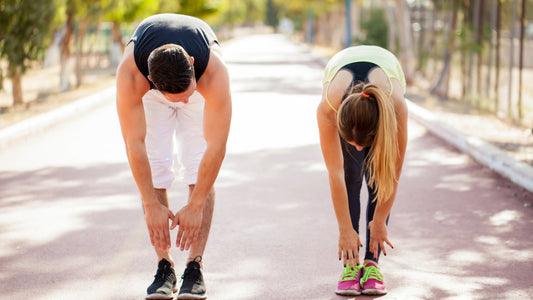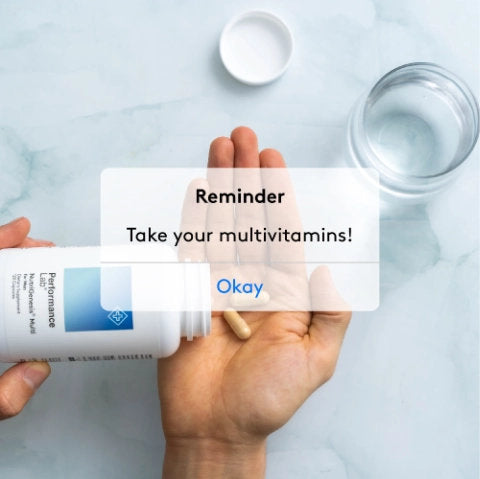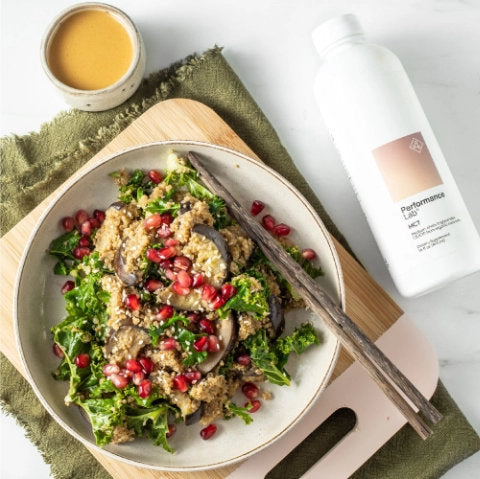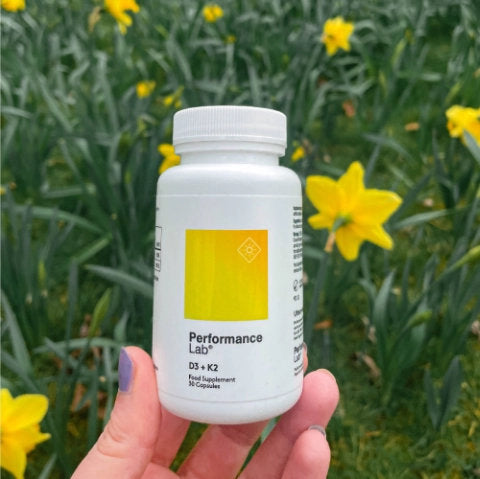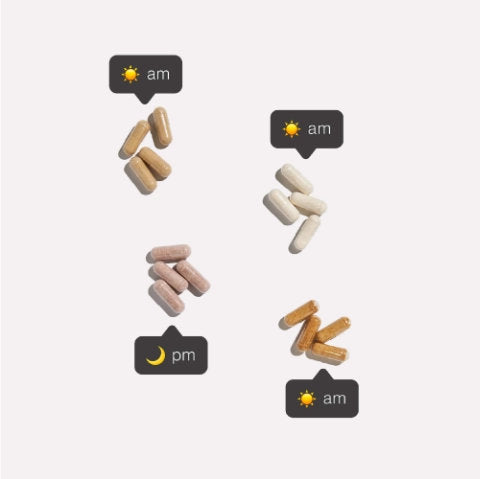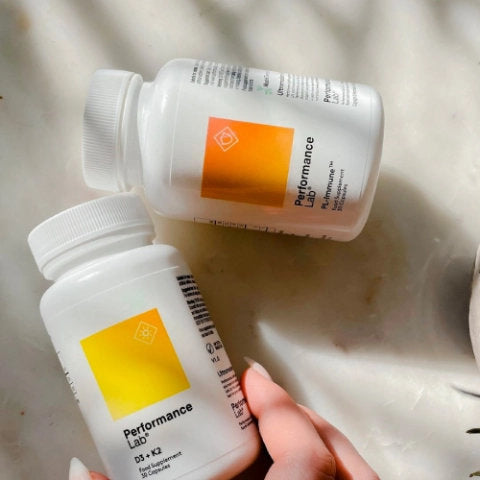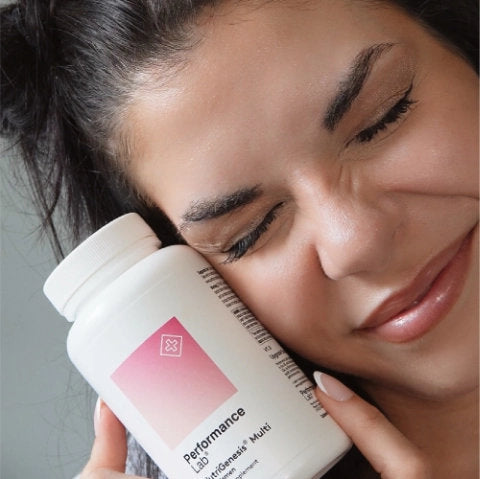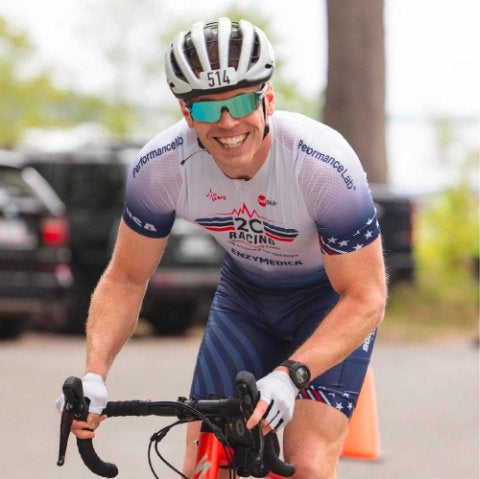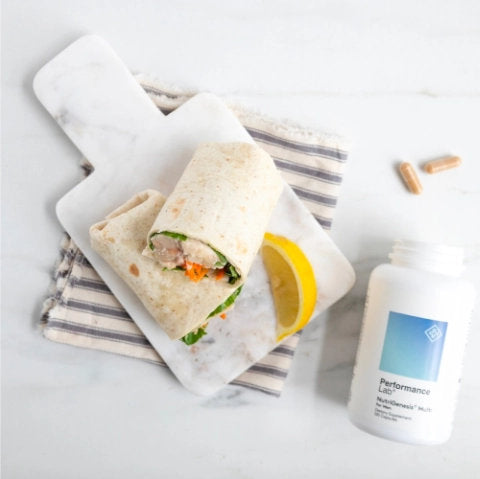Overuse injuries are common among athletes and can impact their performance and recovery. [19, 22]
Whether you're perfecting your baseball swing or aiming for a PR on your front squat, inflammation is part of the recovery process. [2, 20] However, when it becomes chronic, it can lead to tendonitis, affecting your mobility and performance. [2, 21]
If tendonitis is something you’ve never heard of before, keep reading to learn how to manage it naturally and reduce pain while alleviating your symptoms.
Key Takeaways
- Tendonitis is the inflammation or irritation of tendons, often caused by repetitive movements or overuse. [22] It leads to pain, swelling, and difficulty in joint mobility, most commonly affecting areas like the shoulder, elbow, wrist, knee, hip, and ankle. [2, 21]
- Causes of tendonitis include repetitive motions in sports, aging, injuries, and certain medical conditions or medications. [27]
- Common types of tendonitis include Achilles tendonitis, tennis elbow, rotator cuff tendonitis, and swimmer’s shoulder. [50]
- Initial treatment options for tendonitis include the RICE method (Rest, Ice, Compression, Elevation), physical therapy, and pain relievers. While these can offer short-term relief, natural supplements can offer long-term support.
- Omega-3 fatty acids may help in reducing inflammation, supporting tendon repair and overall joint health. [3, 43, 44] Curcumin and Boswellia are also potent anti-inflammatories that may help to ease pain and promote healing in tendons. [4, 5, 7, 42]
- Collagen supplements, particularly hydrolyzed collagen, aid in tendon repair by supporting collagen synthesis, which is essential for tendon strength and flexibility. [38, 39, 40] Vitamin C is also critical for collagen production. [37]
- MSM and glucosamine-chondroitin sulfate are key supplements for improving joint function and aiding tendon recovery, thanks to their anti-inflammatory properties and ability to support cartilage and tendon health. [9, 10, 11, 12]
- Rest and recovery are essential, and Performance Lab Flex offers a targeted supplement solution with ingredients like Boswellia and curcumin to soothe and protect tendons. [32]
- For long-term support and recovery, using a combination of natural supplements, physical therapy, and proper rest can help prevent and treat tendonitis, supporting the healing process and ensuring sustained mobility and performance. [32, 36]
What Is Tendonitis and What Causes It?

Tendonitis refers to the inflammation or irritation of a tendon—the thick, fibrous tissue that connects muscle to bone. Tendons are primarily composed of collagen fibres, which provide strength and flexibility.
Collagen is the most abundant form of protein in our bodies and is found not only in tendons but other connective tissues like skin and muscles as well. [1]
Tendonitis causes acute pain, swelling, and tenderness in the injured tendon, and it often makes it difficult to move the affected joint. [2]
-
The joints most commonly affected by tendonitis include the shoulder, elbow, wrist, hip, knee, and ankle.
While the pain tends to worsen with movement, it can also radiate to areas away from the joint. [23]
The most common cause of tendonitis is repetitive motion. [2]
Athletes who repeatedly perform the same movements are particularly at risk, as this can lead to tendon irritation and inflammation. When movements are performed incorrectly or with poor technique, the risk of developing chronic tendon disorders, such as tendinopathy and tendonitis, increases. [2]
For non-athletes, other possible causes of tendonitis include:
- Aging: Tendons become less flexible and more prone to injury with age. [24]
- Injury: Acute injuries can inflame tendons. [25, 26]
- Medical Conditions: Conditions like rheumatoid arthritis and diabetes can increase the likelihood of tendonitis. [27]
- Medications: Certain antibiotics have been linked to tendon inflammation. [28]
Bursitis, though often mentioned alongside tendonitis, is slightly different and involves inflammation of the bursa—a small fluid-filled sac that cushions areas where bones, muscles, and tendons move against one another. When the bursa becomes inflamed, it can cause sharp pain, even without movement, especially where muscles or tendons pull over bony areas. [29]
Common Types of Tendonitis
While any tendon in the body can become inflamed, some are more commonly affected in athletes:
- Achilles tendonitis
- Patellar tendon (kneecap)
- Rotator cuff (shoulder)
- Posterior tibial tendonitis
- Lateral epicondylitis (tennis elbow)
- Wrist tendonitis
These common types of tendonitis are named after the activity or location where the injury occurs, such as ‘golfer’s elbow’ or ‘swimmer’s shoulder.' Achilles injury is one of the most common tendon problems in athletes.
Some of the interventions that have been shown to treat tendinopathy include [2]:
- Eccentric strengthening protocols
- Sclerotherapy
- Nitric oxide patches
- Growth factor and stem cell therapy
Treatment Options For Tendonitis

A common initial treatment for musculoskeletal conditions like tendonitis is the RICE method, believed to reduce inflammation and improve blood circulation, promoting faster healing. However, recent research puts the effectiveness of this method into question. [30]
Other traditional methods, such as corticosteroid injections and nonsteroidal anti-inflammatory drugs (NSAIDs), are often used to manage inflammation, though they may not be the most effective or best long-term solutions. [2]
-
Other treatments, including shockwave therapy, GTN patches, and tendon injections, are sometimes paired with exercise therapy to enhance tendon healing and pain relief.
A strength training programme is also beneficial for tendon rehabilitation, as it helps restore function and tendon strength. [2]
The primary goal of tendonitis treatment is to relieve pain, reduce inflammation, and maintain mobility. [27] Here are some approaches explained in more detail:
RICE method
While its effectiveness is a topic of discussion, Rest, Ice, Compression, and Elevation (RICE) remains a go-to among many experts for soft tissue injuries. Rest allows the tendon to heal; ice reduces swelling; compression supports the injured area; and elevation minimizes fluid buildup. [27, 31, 32, 33, 34]
Physical Therapy and Rehab Exercises
Depending on the injury's severity, a physical therapist may use hot or cold therapy, ultrasound, laser treatments, or water therapy to accelerate healing. Manual therapies like joint or soft tissue mobilization can also support recovery.
Pain relievers
Over-the-counter (OTC) painkillers such as ibuprofen or NSAIDs are often prescribed to manage the discomfort caused by inflammation. However, these are short-term solutions and do not address the root cause.
Additional treatments
Other therapies, including stretching, strengthening exercises, corticosteroid injections, glycerol trinitrate patches, and growth factors, have been explored for tendonitis relief. However, these may not always be necessary for mild cases.
For long-term relief and healing, natural supplements are a healthier and safer alternative. [8, 35, 36] They may reduce chronic inflammation and support joint and tendon health without the side effects associated with conventional medications. [8, 36]
What Research Says About Supplements for Tendon Repair

Studies show that specific collagen peptides, hydrolysed collagen supplement, and vitamin C-enriched gelatine can boost collagen synthesis. This, in turn, may promote healthy tendon growth and faster healing. [37, 38, 39, 40]
A study found that taking 15 grams of gelatine before exercise can significantly increase collagen synthesis after the activity. [15]
-
If you want to enhance collagen by directly taking collagen supplements, consider taking hydrolysed collagen. It is easier to absorb than other collagen types. [41]
Amino acids like leucine (an essential amino acid) also play a role in collagen production, and by extension, tendon support. [51]
In the early phase of healing, some supplements may promote the growth of blood vessels, which is essential for full recovery. [16, 17]
Anti-inflammatory supplements like Boswellia also show promise. Boswellia has been shown to reduce oxygen radicals, inhibit leukocyte elastase, modulate the complement system, and affect other factors that help in controlling inflammation. [18]
Best Supplements For Tendonitis and Overall Tendon Health
If you’re looking to avoid the prescription route for treating your joint and tendon health, oral supplementation with these products can help reduce inflammation and support the recovery process:
Omega-3

The potent anti-inflammatory effects of omega-3s may support the management of tendonitis and other inflammatory conditions.
Several studies have found that long-chain fatty acids influence inflammation through several mechanisms.
Many of these effects are at least partially mediated by changes in the fatty acid composition of cell membranes.
Altering the composition of cell membranes can modify membrane fluidity, cell signaling, gene expression, and the pattern of lipid mediator production. [3]
Many of the cells involved in the inflammatory response are rich in the omega-6 fatty acid arachidonic acid and the omega-3s eicosapentaenoic acid (EPA) and docosahexaenoic acid (DHA), but oral administration of EPA and DHA can alter the membrane concentrations.
EPA and DHA give rise to resolvins, which are anti-inflammatory. [3]
-
Unlike fish oil supplements, which may contain toxins or contaminants, Performance Lab® Omega-3 offers clean, sustainable DHA+EPA derived from algae in an ideal 2:1 DHA to EPA ratio.
These vegan softgels are free from heavy metals such as mercury, environmental toxins like PCBs, and other harmful substances often found in traditional fish oil supplements.
Curcumin to Reduce Inflammation

Like omega-3 fatty acids, curcumin is a great supplement to help manage inflammation in the body.
Curcumin, the active constituent of turmeric, has potent anti-inflammatory properties that help to soothe and support achy joints, reduce joint pain, and help mitigate the effects of inflammation.
Despite being part of the Zingiberaceae (ginger) family, turmeric contains different bioactive compounds responsible for its specific properties.
Turmeric and its derivatives possess potent anti-inflammatory activities, but unlike other anti-inflammatories that modulate COX-1 activity, turmeric modifies NF-κB signaling, pro-inflammatory cytokines, COX-2, and 5-LOX activity. [4]
A rodent study looked at the effects of curcumin for tendon healing and found that 200 mg/kg orally for 28 days elicited better results for total tendon healing both histologically and biomechanically, [5] suggesting that curcumin may be an effective treatment for healing tendon conditions.
Another study used human tenocytes to study the mechanism of curcumin’s action on inflammatory signaling. [6]
At concentrations of 5-20μm, curcumin appeared to inhibit IL-1β-induced inflammation and apoptosis; it helped down-regulate gene products that mediate matrix degradation, prostanoid production (COX-2), apoptosis, and stimulated cell survival.
Additionally, curcumin also suppressed IL-1β-induced NF-κB activation. Research concluded that curcumin helps to counteract significant inflammatory pathways involved in the development of tendonitis.
Boswellia

Because the goal of any supplements used for tendonitis is to reduce inflammation, Boswellia is another effective option.
Also known as Indian Frankincense, Boswellia serrata and its gum-resin extracts have been used for centuries in various chronic inflammatory conditions.
According to studies, the four boswellic acids are largely responsible for inhibiting pro-inflammatory enzymes; acetyl-11-keto-β-boswellic acid appears to be the most potent inhibitor of 5-lipoxygenase, an enzyme responsible for inducing inflammation. [7]
It may also modulate the expression of pro-inflammatory cytokines and reduce reactive oxygen species (ROS) involved in the inflammatory process.
BA also prevents the TNF α-induced expression of matrix metalloproteinases MMP-3 and MMP-10. [8]
Taken together, by modulating levels of pro-inflammatory cytokines, Boswellia may offer support for tendinopathies.
Collagen

Collagen is an essential protein that plays a key role in maintaining the structure of tendons and other connective tissues.
Collagen supplements, particularly hydrolysed collagen, have been shown to support tendon repair by promoting collagen synthesis, which is critical for tendon strength and flexibility.
Hydrolysed collagen is collagen that is broken down into smaller particles, making it easier for the body to absorb.
When combined with physical activity, collagen can help accelerate recovery from tendon injuries and improve overall tendon health. [38, 45]
Along with collagen, vitamin C is essential for collagen production. You can pair collagen supplements with a vitamin C-rich diet or a vitamin C supplement to maximize tendon recovery. [46]
MSM

Methylsulfonylmethane (MSM) is a naturally occurring organosulfur compound that’s used in the management of pain, inflammation, allergies, infections, and many other conditions.
MSM is one of the top supplements for supporting joint health and has been shown to be highly effective for rapidly reducing pain, swelling, and improving the functional ability of joints. [9]
Research suggests that MSM's potent anti-inflammatory effects result from its inhibitory effect on NF-κB, resulting in downregulation of interleukin (IL)-1, IL-6, and tumor necrosis factor-α (TNF-α) synthesis—all markers of inflammation.
Due to its ability to inhibit NF-κB transcriptional activity, it also reduces the expression of enzymes and cytokines involved in free-radical formation; high levels of circulating free-radicals are an underlying factor for the development of many inflammatory conditions. [10]
Glucosamine Sulfate
Glucosamine and chondroitin are two of the most popular supplements when it comes to joint health. They are two building blocks of cartilage, the tissue that cushions joints, and supplementing with them may help to prevent breakdown associated with natural wear and tear or conditions affecting the joints.
Studies support the use of glucosamine-chondroitin sulfate in treating tendon injuries; it appears to enhance tendon-to-bone healing by increasing hyaline cartilage formation and decreasing the formation of capillary vessels. [11]
Another study found that supplementation with glucosamine chondroitin sulfate improved results of Achilles tendon healing in rodents, which may be due to decreased inflammation and stimulation of collagen synthesis. [12]
Should I Keep Training With Achilles Tendon Pain or Tendonitis?

It's tempting to push through an injury, thinking you'll take it easy and be fine. But continuing to train with tendonitis can often make things worse, especially for injuries like Achilles tendinopathy, which require careful management to avoid further aggravation. [32]
Painkillers may mask the discomfort, but they can also prevent you from realizing the injury is getting worse. [47]
What Is the Best Supplement for Tendon and Joint Health? Here's Our #1 Pick
If you're looking to support your training and recovery routine, Performance Lab Flex is a supplement worth exploring.
Flex is one of the highest-quality joint supplements to support active lifestyles.
Whether you're recovering from an injury or looking for long-term joint health, Flex’s advanced formula targets the demands of active joints, tendons, and ligaments.

It combines easy-on-the-stomach botanicals like AprèsFlex® Boswellia Serrata and CurcuWIN® curcumin with clinically-studied joint lubricants like Phytodroitin™ chondroitin, OptiMSM®, and corn glucosamine—all delivered in vegan-friendly, prebiotic-infused capsules.
Whether you’re an athlete who trains multiple times per day or you work in a profession where repetitive movements cause pain and stiffness, getting the right supplements is key to maintenance, prevention, and treatment support.
There are many options available when something like tendonitis flares up—manual therapy, NSAIDs, analgesics. On the other hand, these supplements may help to prevent and support treatment, providing a long-term solution for healthy soft tissues no matter your daily activities. [8, 36, 48]
However, this comes with a caveat. The majority of clinical studies on supplements for tendon management have methodological limitations, so further research is needed to establish their efficacy conclusively.
Your Questions About Tendonitis Supplements—Answered

What Vitamin Deficiency Can Cause Tendonitis or Weak Tendons?
While it's not clear whether vitamin deficiencies can directly cause tendonitis or weak tendons, they are, at the very least, a contributing factor. [52]
Nutrients that play a role in supporting healthy tendon growth, repair, and protection include vitamin C, zinc, vitamin D, copper, and vitamin B12. [36, 53]
Vitamin C, for example, is essential for collagen synthesis, which contributes to keeping your tendons healthy and strong. [13]
Do Joint Supplements Help Tendonitis Recovery?
Yes, joint supplements can aid in the tendon healing process.
These include amino acids, vitamins C and D, minerals, collagen, and other nutrients, as well as herbs like turmeric and Boswellia serrata, which may reduce pain and inflammation.
Needless to say, this doesn't mean that supplements are a cure-all. For some people, they may lead to big improvements in their tendon health and function.
For others, supplements may not make much difference, or they may need to be used together with rest, therapy, and medication to produce meaningful results.
Is Glucosamine or Omega-3 Better for Joints and Tendons?
Glucosamine is a necessary building block for your cartilage and may protect against its breakdown.
On the other hand, omega-3s might help reduce inflammation and pain from Achilles tendonitis and similar conditions. They tend to work better when taken together than individually. [14]
Does Magnesium Repair Tendons?
Tendon healing can be a slow process. Supplements like magnesium are generally not able to directly repair tendons.
However, magnesium can contribute to tendon repair to an extent. It does this by reducing inflammatory markers that are known to negatively impact joint health. [49]
References
- Riley G. (2004). The pathogenesis of tendinopathy. A molecular perspective. Rheumatology (Oxford, England), 43(2), 131–142. https://doi.org/10.1093/rheumatology/keg448
- Andres, B. M., & Murrell, G. A. (2008). Treatment of tendinopathy: what works, what does not, and what is on the horizon. Clinical orthopaedics and related research, 466(7), 1539–1554. https://doi.org/10.1007/s11999-008-0260-1
- Calder P. C. (2010). Omega-3 fatty acids and inflammatory processes. Nutrients, 2(3), 355–374. https://doi.org/10.3390/nu2030355
- Daily, J. W., Yang, M., & Park, S. (2016). Efficacy of Turmeric Extracts and Curcumin for Alleviating the Symptoms of Joint Arthritis: A Systematic Review and Meta-Analysis of Randomized Clinical Trials. Journal of medicinal food, 19(8), 717–729. https://doi.org/10.1089/jmf.2016.3705
- Güleç, A., Türk, Y., Aydin, B. K., Erkoçak, Ö. F., Safalı, S., & Ugurluoglu, C. (2018). Effect of curcumin on tendon healing: an experimental study in a rat model of Achilles tendon injury. International orthopaedics, 42(8), 1905–1910. https://doi.org/10.1007/s00264-018-4017-5
- Buhrmann, C., Mobasheri, A., Busch, F., Aldinger, C., Stahlmann, R., Montaseri, A., & Shakibaei, M. (2011). Curcumin modulates nuclear factor kappaB (NF-kappaB)-mediated inflammation in human tenocytes in vitro: role of the phosphatidylinositol 3-kinase/Akt pathway. The Journal of biological chemistry, 286(32), 28556–28566. https://doi.org/10.1074/jbc.M111.256180
- Siddiqui M. Z. (2011). Boswellia serrata, a potential antiinflammatory agent: an overview. Indian journal of pharmaceutical sciences, 73(3), 255–261. https://pubmed.ncbi.nlm.nih.gov/22457547/
- Fusini, F., Bisicchia, S., Bottegoni, C., Gigante, A., Zanchini, F., & Busilacchi, A. (2016). Nutraceutical supplement in the management of tendinopathies: a systematic review. Muscles, ligaments and tendons journal, 6(1), 48–57. https://pubmed.ncbi.nlm.nih.gov/27331031/
- Usha, P. R., & Naidu, M. U. (2004). Randomised, Double-Blind, Parallel, Placebo-Controlled Study of Oral Glucosamine, Methylsulfonylmethane and their Combination in Osteoarthritis. Clinical drug investigation, 24(6), 353–363. https://doi.org/10.2165/00044011-200424060-00005
- Sengupta, K., Alluri, K. V., Satish, A. R., Mishra, S., Golakoti, T., Sarma, K. V., Dey, D., & Raychaudhuri, S. P. (2008). A double blind, randomized, placebo controlled study of the efficacy and safety of 5-Loxin for treatment of osteoarthritis of the knee. Arthritis research & therapy, 10(4), R85. https://doi.org/10.1186/ar2461
- A Taşkesen, B Ataoğlu, M Özer, I Demirkale, S Turanli. Glucosamine-chondroitin sulphate accelerates tendon-to-bone healing in rabbits. Eklem Hastalik Cerrahisi. 2015;26(2):77-83.
- Ozer, H., Taşkesen, A., Kul, O., Selek, H. Y., Turanlı, S., & Köse, K. (2011). Glukozamin kondroitin sülfatın onarılmış tenotomize sıçan Aşil tendonları üzerine etkisi [Effect of glucosamine chondroitine sulphate on repaired tenotomized rat Achilles tendons]. Eklem hastaliklari ve cerrahisi = Joint diseases & related surgery, 22(2), 100–106. https://pubmed.ncbi.nlm.nih.gov/21762066/
- Curtis L. (2016). Nutritional research may be useful in treating tendon injuries. Nutrition (Burbank, Los Angeles County, Calif.), 32(6), 617–619. https://doi.org/10.1016/j.nut.2015.12.039
- Gruenwald, J., Petzold, E., Busch, R., Petzold, H. P., & Graubaum, H. J. (2009). Effect of glucosamine sulfate with or without omega-3 fatty acids in patients with osteoarthritis. Advances in therapy, 26(9), 858–871. https://doi.org/10.1007/s12325-009-0060-3
- Shaw, G., Lee-Barthel, A., Ross, M. L., Wang, B., & Baar, K. (2017). Vitamin C-enriched gelatin supplementation before intermittent activity augments collagen synthesis. The American journal of clinical nutrition, 105(1), 136–143. https://doi.org/10.3945/ajcn.116.138594
- Li, Z. J., Yang, Q. Q., & Zhou, Y. L. (2023). Biological and Mechanical Factors and Epigenetic Regulation Involved in Tendon Healing. Stem cells international, 2023, 4387630. https://doi.org/10.1155/2023/4387630
- Omeroğlu, S., Peker, T., Türközkan, N., & Omeroğlu, H. (2009). High-dose vitamin C supplementation accelerates the Achilles tendon healing in healthy rats. Archives of orthopaedic and trauma surgery, 129(2), 281–286. https://doi.org/10.1007/s00402-008-0603-0
- Safayhi, H., Rall, B., Sailer, E. R., & Ammon, H. P. T. (1997). Inhibition by boswellic acids of human leukocyte elastase. The Journal of Pharmacology and Experimental Therapeutics, 281(1), 460–463. https://pubmed.ncbi.nlm.nih.gov/9103531/
- Franco, M. F., Madaleno, F. O., de Paula, T. M. N., Ferreira, T. V., Pinto, R. Z., & Resende, R. A. (2021). Prevalence of overuse injuries in athletes from individual and team sports: A systematic review with meta-analysis and GRADE recommendations. Brazilian journal of physical therapy, 25(5), 500–513. https://doi.org/10.1016/j.bjpt.2021.04.013
- Peake, J. M., Neubauer, O., Della Gatta, P. A., & Nosaka, K. (2017). Muscle damage and inflammation during recovery from exercise. Journal of applied physiology (Bethesda, Md. : 1985), 122(3), 559–570. https://doi.org/10.1152/japplphysiol.00971.2016
- Kwan, K. Y. C., Ng, K. W. K., Rao, Y., Zhu, C., Qi, S., Tuan, R. S., Ker, D. F. E., & Wang, D. M. (2023). Effect of Aging on Tendon Biology, Biomechanics and Implications for Treatment Approaches. International journal of molecular sciences, 24(20), 15183. https://doi.org/10.3390/ijms242015183
- Charnoff, J., Ponnarasu, S., Sina, R. E., & et al. (2025, March 28). Tendinosis. In StatPearls. StatPearls Publishing. Retrieved from https://www.ncbi.nlm.nih.gov/books/NBK448174/
- Varacallo, M. A., & Mair, S. D. (2023, August 4). Proximal biceps tendinitis and tendinopathy. In StatPearls. StatPearls Publishing. Retrieved from https://www.ncbi.nlm.nih.gov/books/NBK533002/
- Kwan, K. Y. C., Ng, K. W. K., Rao, Y., Zhu, C., Qi, S., Tuan, R. S., Ker, D. F. E., & Wang, D. M. (2023). Effect of Aging on Tendon Biology, Biomechanics and Implications for Treatment Approaches. International journal of molecular sciences, 24(20), 15183. https://doi.org/10.3390/ijms242015183
- Thomopoulos, S., Parks, W. C., Rifkin, D. B., & Derwin, K. A. (2015). Mechanisms of tendon injury and repair. Journal of orthopaedic research : official publication of the Orthopaedic Research Society, 33(6), 832–839. https://doi.org/10.1002/jor.22806
- Thomopoulos, S., Parks, W. C., Rifkin, D. B., & Derwin, K. A. (2015). Mechanisms of tendon injury and repair. Journal of orthopaedic research : official publication of the Orthopaedic Research Society, 33(6), 832–839. https://doi.org/10.1002/jor.22806
- Institute for Quality and Efficiency in Health Care (IQWiG). (2022, March 29). Overview: Tendon overuse injuries (tendinopathy). In InformedHealth.org. Cologne, Germany: Institute for Quality and Efficiency in Health Care (IQWiG). Retrieved from https://www.ncbi.nlm.nih.gov/books/NBK555501/
- Lewis, T., & Cook, J. (2014). Fluoroquinolones and tendinopathy: a guide for athletes and sports clinicians and a systematic review of the literature. Journal of athletic training, 49(3), 422–427. https://doi.org/10.4085/1062-6050-49.2.09
- Williams, C. H., Jamal, Z., & Sternard, B. T. (2023, July 24). Bursitis. In StatPearls. StatPearls Publishing. Retrieved from https://www.ncbi.nlm.nih.gov/books/NBK513340/
- Scialoia, D., & Swartzendruber, A. J. (2020). The R.I.C.E. protocol is a myth: A review and recommendations. The Sport Journal. Retrieved from https://thesportjournal.org/article/the-r-i-c-e-protocol-is-a-myth-a-review-and-recommendations/
- Wang, Z. R., & Ni, G. X. (2021). Is it time to put traditional cold therapy in rehabilitation of soft-tissue injuries out to pasture?. World journal of clinical cases, 9(17), 4116–4122. https://doi.org/10.12998/wjcc.v9.i17.4116
- Institute for Quality and Efficiency in Health Care (IQWiG). (2022, March 29). Tendon overuse injuries (tendinopathy): Learn more – How are tendon overuse injuries treated? In InformedHealth.org. Cologne, Germany: Institute for Quality and Efficiency in Health Care (IQWiG). Retrieved from https://www.ncbi.nlm.nih.gov/books/NBK555500/
- Tsang, K. K., Hertel, J., & Denegar, C. R. (2003). Volume Decreases After Elevation and Intermittent Compression of Postacute Ankle Sprains Are Negated by Gravity-Dependent Positioning. Journal of athletic training, 38(4), 320–324. https://pmc.ncbi.nlm.nih.gov/articles/PMC314391/#:~:text=In%20conclusion%2C%20although%20ankle%20volume,in%20the%20presence%20of%20edema.
- Tran, K., & Argáez, C. (2020, May 1). External supports for the treatment of ankle sprain: A review of clinical effectiveness. Canadian Agency for Drugs and Technologies in Health. Retrieved from https://www.ncbi.nlm.nih.gov/books/NBK563450/
- Ghlichloo, I., & Gerriets, V. (2023, May 1). Nonsteroidal anti-inflammatory drugs (NSAIDs). In StatPearls. StatPearls Publishing. https://www.ncbi.nlm.nih.gov/books/NBK547742/
- Hijlkema, A., Roozenboom, C., Mensink, M., & Zwerver, J. (2022). The impact of nutrition on tendon health and tendinopathy: a systematic review. Journal of the International Society of Sports Nutrition, 19(1), 474–504. https://doi.org/10.1080/15502783.2022.2104130
- DePhillipo, N. N., Aman, Z. S., Kennedy, M. I., Begley, J. P., Moatshe, G., & LaPrade, R. F. (2018). Efficacy of Vitamin C Supplementation on Collagen Synthesis and Oxidative Stress After Musculoskeletal Injuries: A Systematic Review. Orthopaedic journal of sports medicine, 6(10), 2325967118804544. https://doi.org/10.1177/2325967118804544
- Khatri, M., Naughton, R. J., Clifford, T., Harper, L. D., & Corr, L. (2021). The effects of collagen peptide supplementation on body composition, collagen synthesis, and recovery from joint injury and exercise: a systematic review. Amino acids, 53(10), 1493–1506. https://doi.org/10.1007/s00726-021-03072-x
- Nulty, C. D., Phelan, K., & Erskine, R. M. (2025). Hydrolysed Collagen Supplementation Enhances Patellar Tendon Adaptations to 12 Weeks' Resistance Training in Middle-Aged Men. European journal of sport science, 25(4), e12281. https://doi.org/10.1002/ejsc.12281
- Shaw, G., Lee-Barthel, A., Ross, M. L., Wang, B., & Baar, K. (2017). Vitamin C-enriched gelatin supplementation before intermittent activity augments collagen synthesis. The American journal of clinical nutrition, 105(1), 136–143. https://doi.org/10.3945/ajcn.116.138594
- León-López, A., Morales-Peñaloza, A., Martínez-Juárez, V. M., Vargas-Torres, A., Zeugolis, D. I., & Aguirre-Álvarez, G. (2019). Hydrolyzed Collagen-Sources and Applications. Molecules (Basel, Switzerland), 24(22), 4031. https://doi.org/10.3390/molecules24224031
- Henrotin, Y., Dierckxsens, Y., Delisse, G., Seidel, L., & Albert, A. (2021). Curcuminoids and Boswellia serrata extracts combination decreases tendinopathy symptoms: findings from an open-label post-observational study. Current medical research and opinion, 37(3), 423–430. https://doi.org/10.1080/03007995.2020.1860923
- Gundogdu, G., Tasci, S. Y., Gundogdu, K., Kapakin, K. A. T., Demirkaya, A. K., Nalci, K. A., Gundogdu, M., Hacimuftuoglu, A., & Abd El-Aty, A. M. (2023). A combination of omega-3 and exercise reduces experimental Achilles tendinopathy induced with a type-1 collagenase in rats. Applied physiology, nutrition, and metabolism = Physiologie appliquee, nutrition et metabolisme, 48(1), 62–73. https://doi.org/10.1139/apnm-2021-0801
- Deng, W., Yi, Z., Yin, E., Lu, R., You, H., & Yuan, X. (2023). Effect of omega-3 polyunsaturated fatty acids supplementation for patients with osteoarthritis: a meta-analysis. Journal of orthopaedic surgery and research, 18(1), 381. https://doi.org/10.1186/s13018-023-03855-w
- Boldt, K. S., Olson, B. L., & Thiele, R. M. (2023). Effects of Collagen and Exercise on Tendon Properties and Pain: A Critically Appraised Topic. Journal of sport rehabilitation, 32(8), 938–941. https://doi.org/10.1123/jsr.2023-0115
- Pullar, J. M., Carr, A. C., & Vissers, M. C. M. (2017). The Roles of Vitamin C in Skin Health. Nutrients, 9(8), 866. https://doi.org/10.3390/nu9080866
- Speed, C., & Wolfarth, B. (2014). Challenges of pain masking in the management of soft tissue disorders: optimizing patient outcomes with a multi-targeted approach. Current medical research and opinion, 30(5), 953–959. https://doi.org/10.1185/03007995.2014.913412
- Liu, X., Machado, G. C., Eyles, J. P., Ravi, V., & Hunter, D. J. (2018). Dietary supplements for treating osteoarthritis: a systematic review and meta-analysis. British journal of sports medicine, 52(3), 167–175. https://doi.org/10.1136/bjsports-2016-097333
- Veronese, N., Pizzol, D., Smith, L., Dominguez, L. J., & Barbagallo, M. (2022). Effect of Magnesium Supplementation on Inflammatory Parameters: A Meta-Analysis of Randomized Controlled Trials. Nutrients, 14(3), 679. https://doi.org/10.3390/nu14030679
- Xu, Y., & Murrell, G. A. (2008). The basic science of tendinopathy. Clinical orthopaedics and related research, 466(7), 1528–1538. https://doi.org/10.1007/s11999-008-0286-4
- Kalamajski, S., & Oldberg, A. (2010). The role of small leucine-rich proteoglycans in collagen fibrillogenesis. Matrix biology : journal of the International Society for Matrix Biology, 29(4), 248–253. https://doi.org/10.1016/j.matbio.2010.01.001
- Tarantino, D., Mottola, R., Sirico, F., Corrado, B., Ruosi, C., Saggini, R., & Pellegrino, R. (2024). Exploring the impact of vitamin D on tendon health: a comprehensive review. Journal of basic and clinical physiology and pharmacology, 35(3), 143–152. https://doi.org/10.1515/jbcpp-2024-0061
- Curtis L. (2016). Nutritional research may be useful in treating tendon injuries. Nutrition (Burbank, Los Angeles County, Calif.), 32(6), 617–619. https://doi.org/10.1016/j.nut.2015.12.039



